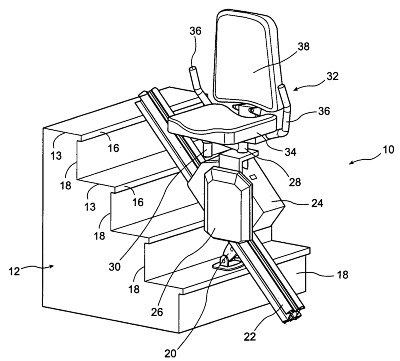The concept of the stair lift dates back to the 1500s, when King Henry VIII of England requested a chair that could go up and down stairs to help him with his mobility issues. The first stair lift was a block and tackle system that relied on servants to use ropes to lift the monarch, seated on the chair lift, up and down the stairs at Whitehall Palace.
It wasn’t until the early 1900s that the modern stair lift as we know it today was invented. In 1924, C.C. Crispen, a car dealer from Pennsylvania, designed and built the first widely-used commercial stair lift, called the “Inclin-ator,” after seeing a friend who was confined to a bed due to a mobility issue. The Inclinator Company of America was founded to manufacture and sell the stair lift, which was initially used by people with polio.
Early home stair lifts operated on AC drive motors and used a simple mechanism consisting of a folding chair and footrest that moved along a track fastened to the stairs. The power cable for the lift was carried along the track in an “energy chain.” As the popularity of stair lifts grew, other companies began to produce their own versions, incorporating technological advancements and more comfortable designs.
In the 1980s, stair lifts began to be powered by rechargeable batteries, which allowed them to continue operating even during power outages. This innovation made stair lifts more convenient and accessible for a wider range of users.
In the 1990s and 2000s, stair lift technology continued to evolve, with the introduction of more advanced control systems and safety features. Stair lifts also became more compact and lightweight, making them easier to install and use.
Today, stair lifts are available in a variety of types and styles to suit different needs and budgets. Straight stair lifts are designed for use on a straight staircase and are generally less expensive and easier to install than curved stair lifts, which are customized to fit a curved staircase. There are also outdoor stair lifts, which are designed to withstand harsh weather conditions, and standing stair lifts, which allow the user to stand while using the lift.
In addition to the type of staircase, there are other factors to consider when choosing a stair lift, such as the weight capacity, the seat and armrest design, and the control options. Some stair lifts are designed specifically for use by people with certain medical conditions, such as arthritis or heart disease, and may have features such as a swivel seat or a power-assisted lift to make it easier for the user to get on and off the chair.
Stair lifts are an essential tool for people with mobility issues, providing convenience and peace of mind for both individuals and their families. They are commonly used in residential homes, but they are also found in commercial buildings, such as schools, hospitals, and office buildings, to provide access to all levels of the building for people with disabilities.
The demand for stair lifts has increased in recent years, as the population continues to age and the prevalence of mobility issues increases. As a result, the stair lift industry has grown significantly, with numerous companies offering a wide range of products and services.
Overall, the history of the stair lift is a fascinating tale that has evolved from a simple block and tackle system used to lift a monarch up and down the stairs to a sophisticated and essential mobility aid used by people around the world.

